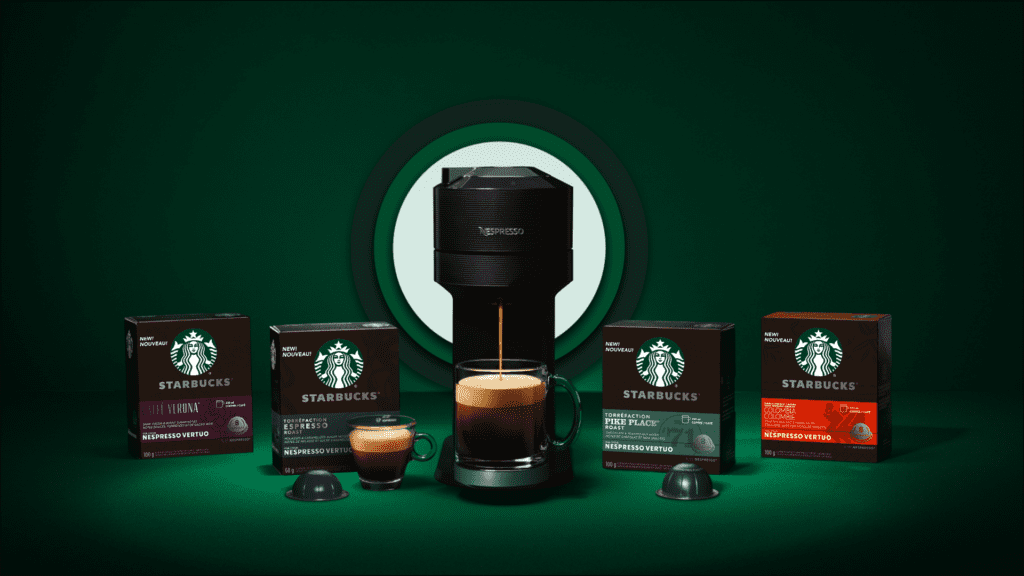The Moka pot, often revered as the classic stovetop espresso maker, has been a staple in coffee enthusiasts’ kitchens for decades. Invented by Alfonso Bialetti in 1933, this iconic coffee maker revolutionized home brewing by offering a simple, yet effective method to create a strong, flavorful coffee reminiscent of espresso. Whether you’re a seasoned barista or a casual coffee drinker, understanding the unique flavor profiles of Moka Pot coffee can elevate your brewing game.
Brewing coffee with a Moka pot isn’t just about making a quick cup; it’s about embracing a ritual that combines tradition, science, and a touch of art. The resulting brew is known for its boldness, intense flavor, and rich aroma, making it a favorite for those who appreciate a robust coffee experience. By delving into the nuances of the Moka pot’s flavor profile, you can unlock new dimensions in your daily coffee ritual, ensuring every sip is as delightful as the first.

Components and Mechanics: A Moka pot is composed of three main parts:
- Bottom Chamber: This section holds the water. When heated, the water turns into steam and creates pressure.
- Filter Basket: Positioned between the bottom and top chambers, this basket holds the ground coffee. The steam from the bottom chamber passes through the coffee grounds, extracting the flavors and oils.
- Top Chamber: The brewed coffee collects in this compartment after passing through the coffee grounds and the funnel.
Why Choose a Moka Pot for Brewing?
Choosing a Moka pot for brewing coffee brings a multitude of benefits, making it a beloved choice for many coffee aficionados. Here’s why a Moka pot might be the perfect brewing method for you:

- 1. Rich and Robust Flavor Moka pots are renowned for producing a coffee that is strong, full-bodied, and intensely flavored. The steam pressure extraction method ensures that the coffee grounds release their rich oils and flavors, resulting in a brew that is more concentrated than drip coffee but less intense than espresso.
- 2. Affordability One of the most appealing aspects of the Moka pot is its cost-effectiveness. While espresso machines can be quite expensive, Moka pots are available at a fraction of the price, typically ranging from $20 to $100. This makes it accessible for those who want to enjoy a strong coffee without breaking the bank.
- 3. Simplicity and Durability The Moka pot’s design is simple yet durable. With no electrical components and few moving parts, it is easy to use and maintain. Made from robust materials like aluminum or stainless steel, a well-cared-for Moka pot can last for many years.
- 4. Portability Due to its compact size and lack of need for electricity, the Moka pot is perfect for travel and outdoor use.
- 5. Hands-On Brewing Experience Using a Moka pot requires attention and involvement, which many coffee lovers find rewarding. The process allows for a deeper connection to the coffee-making ritual, offering the satisfaction of crafting a perfect cup with your own hands.
- 6. Environmental Friendliness Moka pots reduce the need for disposable coffee pods or paper filters, making them a more sustainable option. Their long-lasting nature and the minimal waste they produce contribute to a lower environmental impact compared to other brewing methods.
- 7. Versatility The Moka pot can be used with a variety of coffee beans and roast levels, allowing you to experiment with different flavors and find your perfect brew.
Factors Influencing Flavor Profile
The type of coffee beans and their roast level play a significant role in shaping the flavor profile of Moka pot coffee. Medium to dark roasts are generally recommended as they bring out a rich, full-bodied taste with a hint of bitterness that complements the Moka pot’s brewing process.

Popular brands like Lavazza, Illy, and Cafe Bustelo are often favored for their consistency and quality, ensuring a satisfying brew each time. The origin of the beans also influences the flavor, with Italian and Cuban beans providing robust and intense flavors, while beans from regions like Sulawesi can offer unique chocolate and fruity notes.
- Grind Size: The grind size is crucial for Moka pot brewing. A medium-fine grind is ideal, finer than what you’d use for a drip coffee maker but coarser than espresso. This grind size allows the steam pressure to extract the coffee flavors efficiently without causing over-extraction, which can result in a bitter taste. Grinding the coffee just before brewing enhances the freshness and flavor of the coffee.
- Water Temperature and Pressure: Water temperature and pressure are vital for achieving the perfect Moka pot coffee. Pre-heating the water before adding it to the Moka pot helps to maintain a consistent brewing temperature, which is essential for extracting the best flavors. Using hot water speeds up the brewing process and reduces the time the coffee grounds are exposed to high temperatures, preventing a burnt taste. The pressure created by the steam forces the water through the coffee grounds, extracting the rich oils and flavors that characterize Moka pot coffee.
These factors combined contribute to the unique, robust, and intense flavor profile that Moka pot coffee enthusiasts love. Understanding and controlling these elements can help you perfect your Moka pot brewing technique and enjoy a consistently excellent cup of coffee.
Flavor Characteristics of Moka Pot Coffee
Typical Flavor Notes
Moka pot coffee is celebrated for its robust and intense flavor, often described as rich and full-bodied. The pressure-driven brewing process extracts deep and complex flavors from the coffee grounds, resulting in a brew that is more concentrated and stronger than drip coffee but less intense than espresso. Typical flavor notes include:
- Bitterness: A pronounced bitterness, often balanced by the natural sweetness of the coffee beans.
- Richness: A deep, satisfying richness that fills the palate.
- Body: A full-bodied mouthfeel, providing a substantial and hearty coffee experience.
- Aroma: A strong, inviting aroma that is a hallmark of Moka pot coffee.

Comparisons to Other Brewing Methods
- Espresso: Moka pot coffee is often likened to espresso due to its strong and concentrated nature. However, it lacks the crema that espresso has, and the flavor can be slightly less refined due to the lower pressure used in the brewing process.
- French Press: While French press coffee is known for its full body and complex flavors, it is typically less intense than Moka pot coffee. The French press method allows more of the coffee’s oils and fine particles into the brew, resulting in a different mouthfeel and flavor complexity.
- Pour Over: Pour-over coffee generally has a cleaner, more delicate flavor profile compared to the boldness of Moka pot coffee. The controlled pour-over method emphasizes clarity and subtlety, making it quite distinct from the robust nature of Moka pot coffee.
Influence of Bean Origin on Flavor
The origin of the coffee beans significantly impacts the flavor profile of the brew. Here are a few notable examples:
- Italian Coffee Beans: Known for their rich and authentic flavor, providing a traditional Moka pot experience with deep, robust notes.
- Cuban Coffee Beans: Often darker roasted, offering a strong, bold flavor with a hint of smokiness, perfect for those who prefer a more intense coffee.
- Sulawesi Kalossi Beans: These beans offer a unique combination of chocolate and fruit flavors, adding complexity and a slight sweetness to the brew.
Understanding these flavor characteristics and their origins can help you tailor your Moka pot brewing to match your taste preferences, making each cup a delightful experience.
Step-by-Step Guide to Brewing for Optimal Flavor

Measure and Grind the Coffee:
- Start by measuring the amount of coffee you need. For a standard Moka pot, use about 20-22 grams of coffee.
- Grind the coffee to a medium-fine consistency. This grind size is crucial to ensure proper extraction without over-extraction.
Fill the Bottom Chamber with Water:
- Pre-heat the water to just below boiling. Using hot water reduces the time the coffee grounds are exposed to heat, preventing a burnt taste.
- Fill the bottom chamber up to the safety valve.
Add Coffee Grounds to the Filter Basket:
- Place the ground coffee into the filter basket and level it off. Avoid tamping the coffee down, as this can affect the pressure and extraction process.
- Make sure there are no coffee grounds on the edges of the filter basket to ensure a proper seal.
Assemble the Moka Pot:
- Screw the top chamber tightly onto the bottom chamber to create a secure seal.
- Ensure that the gasket and the filter are clean and in good condition to prevent leaks.
Apply Heat:
- Place the Moka pot on the stovetop over medium heat. If using an electric stove, start with high heat and reduce once brewing begins.
- Monitor the brewing process closely. The coffee will start to gurgle and rise into the top chamber.
Control the Temperature:
- Once the coffee starts flowing, adjust the heat to maintain a steady flow. Aim for a golden or honey-colored stream.
- If the flow is too fast or too dark, reduce the heat or lift the pot slightly off the burner to control the temperature.
Remove from Heat and Serve:
- As soon as the top chamber is full and the bubbling sound subsides, remove the Moka pot from the heat.
- Pour the coffee immediately to prevent over-extraction and bitterness.
Tips on Maximizing Moka Pot Flavor Profile
You’ve got the rundown, you know the pros and cons, but how do you go from Moka Pot newbie to full-on coffee wizard? Allow me to share some expert tips that’ll make your Moka Pot sing like Adele hitting the high notes.
1. Preheat Your Water:
Skip the long wait and potential burn by preheating your water before adding it to the bottom chamber. Not only does this speed up the process, but it also helps avoid overcooking your coffee.

2. The Grind is Key:
Go for a medium grind—coarser than espresso but finer than drip. This is the sweet spot that maximizes flavor extraction without making your coffee bitter or too weak.
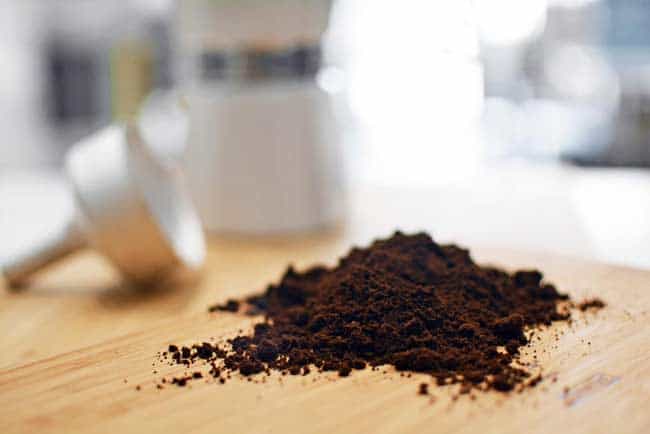
3. Low and Slow Wins the Race:
Keep your heat low to medium, giving your coffee time to extract all those lovely flavors. Crank the heat too high, and you’re on the fast track to Bittertown.
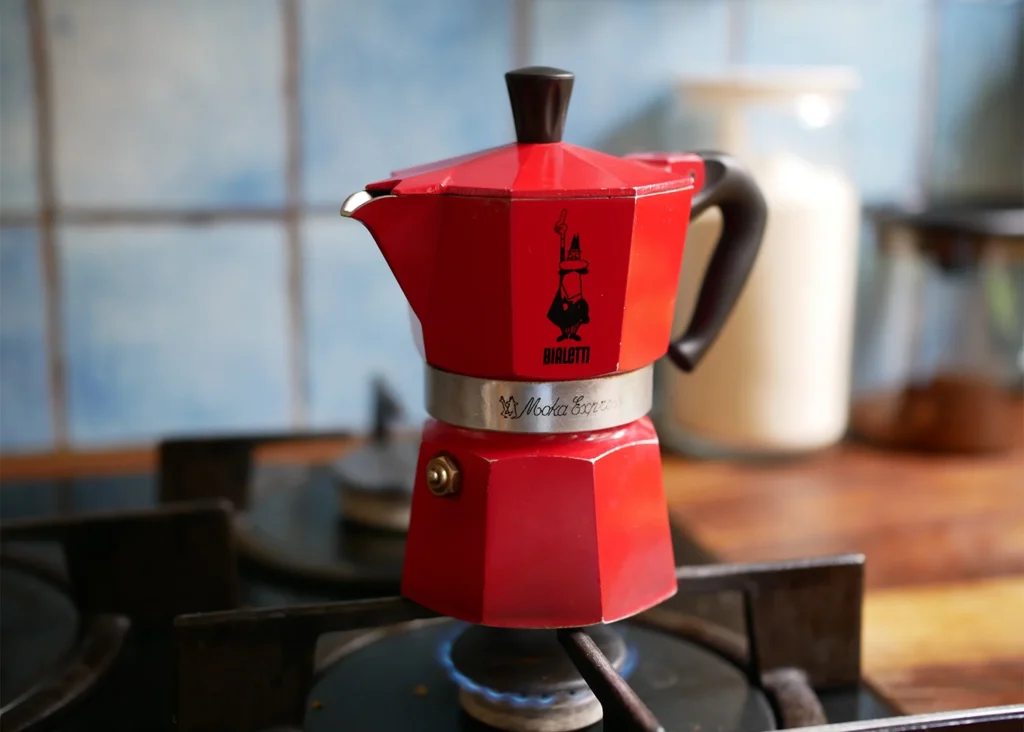
4. Break the Bubbles:
Once the coffee starts filling the upper chamber, give it a little stir to break up any air bubbles. This ensures a more even distribution of flavors, and who doesn’t like a well-mixed brew?
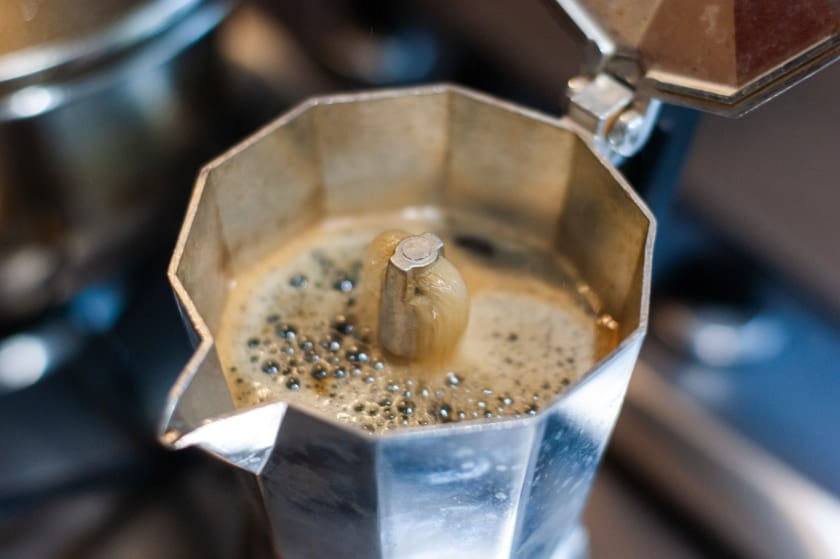
5. End on a High Note:
Right when you think your coffee is done, remove it from the heat and cool the bottom chamber under a tap. This will halt the brewing process, leaving you with the perfect cup.
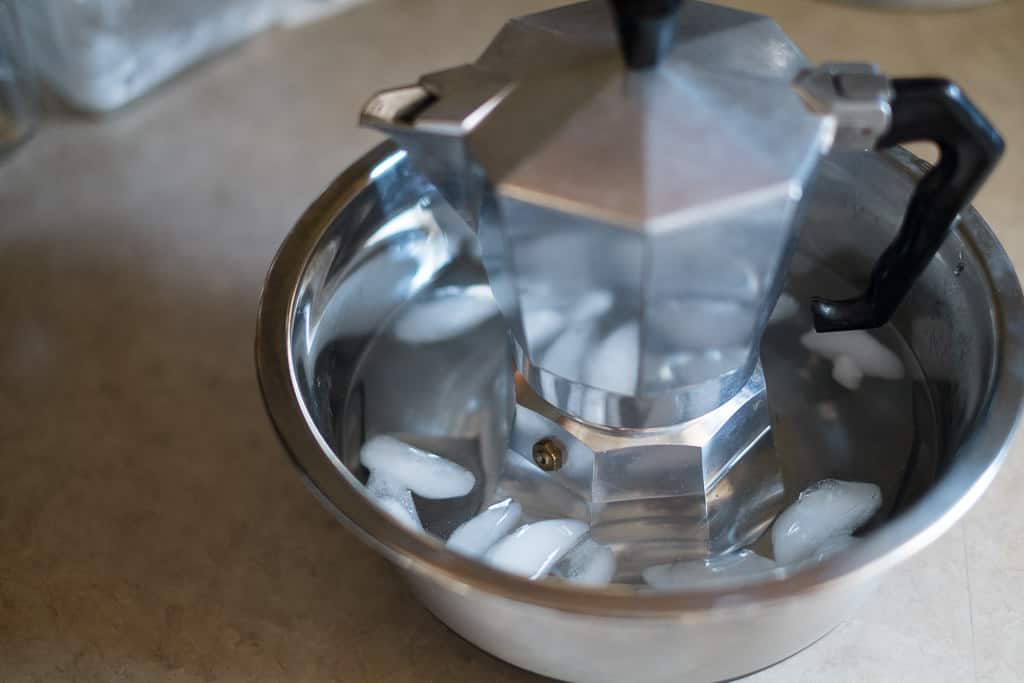
Common Mistakes to Avoid
- Overfilling the Filter Basket: Overfilling can lead to uneven extraction and a bitter taste.
- Using Cold Water: Cold water increases the brewing time and can result in a burnt flavor.
- Ignoring the Grind Size: An incorrect grind size can either cause under-extraction (too coarse) or over-extraction (too fine).
- Not Monitoring the Brewing Process: Leaving the Moka pot unattended can lead to over-extraction and burnt coffee.
Cleaning and Maintenance Tips
- Clean After Every Use: Disassemble the Moka pot and rinse each part with warm water. Avoid using soap, as it can affect the flavor of future brews.
- Inspect the Gasket and Filter: Regularly check the rubber gasket and metal filter for wear and tear. Replace them as needed to maintain a proper seal.
- Avoid the Dishwasher: Hand wash the Moka pot to prevent damage, especially if it’s made of aluminum.
- Dry Thoroughly: Ensure all parts are completely dry before reassembling to prevent oxidation and mold growth.
Proper brewing and maintenance techniques will help you achieve the best flavor and extend the life of your Moka pot, ensuring you enjoy a perfect cup of coffee every time.
Pros and Cons of Moka Pot Coffee
Advantages of Using a Moka Pot
- Rich and Intense Flavor:
- Moka pot coffee is renowned for its strong, robust flavor, offering a full-bodied experience that closely resembles espresso. The unique brewing process allows for optimal extraction of coffee oils, resulting in a flavorful and aromatic cup of coffee.
- Affordability:
- Compared to espresso machines, Moka pots are much more affordable. They typically range from $20 to $100, making them accessible for coffee enthusiasts who want to enjoy quality coffee without a hefty price tag.
- Simplicity and Durability:
- The Moka pot’s design is straightforward, with no complex parts or electronic components. This simplicity makes it easy to use and maintain. With proper care, a Moka pot can last for many years, providing a reliable brewing method.
- Portability:
- Due to its compact size and lack of electrical dependency, the Moka pot is perfect for travel and outdoor adventures. Whether you’re camping or just on the go, you can enjoy a strong cup of coffee anywhere you have access to a heat source.
- Environmental Friendliness:
- Using a Moka pot reduces the need for disposable coffee pods or filters, making it a more environmentally friendly choice compared to many other coffee brewing methods.
Limitations and Challenges
- Requires Constant Supervision:
- Brewing with a Moka pot demands attention throughout the process. Unlike automated coffee makers, you need to monitor the heat and brewing progress to prevent over-extraction or burning.
- Cleaning Complexities:
- The Moka pot consists of multiple small parts that require thorough cleaning after each use. Disassembling and cleaning the filter basket, gasket, and chambers can be time-consuming and tedious.
- Learning Curve:
- Achieving the perfect cup of coffee with a Moka pot takes practice and patience. Factors such as grind size, water temperature, and brewing time all significantly impact the final flavor, requiring some trial and error to master.
- Limited Capacity:
- Moka pots typically brew small quantities of coffee at a time, usually between 1 to 12 cups, depending on the size of the pot. This limitation can be inconvenient when brewing for multiple people or larger gatherings.
- Potential for Over-Extraction:
- If not monitored carefully, the Moka pot can over-extract the coffee, leading to a bitter taste. Controlling the heat and brewing time is crucial to avoid this issue.
Conclusion
The Moka pot, a timeless coffee brewing device, continues to captivate coffee enthusiasts with its ability to produce rich, robust, and intensely flavored coffee. Its history, dating back to 1933 with Alfonso Bialetti’s innovative design, showcases its enduring appeal and effectiveness. The unique mechanics of the Moka pot, involving steam pressure and careful extraction, create a brew that stands out in both flavor and aroma.
Understanding the factors that influence the flavor profile of Moka pot coffee, such as the type of beans, grind size, and water temperature, allows you to tailor your brewing process to achieve the best possible cup. Despite the need for constant supervision and the cleaning complexities, the advantages of using a Moka pot—including affordability, simplicity, durability, and portability—make it a valuable addition to any coffee lover’s kitchen.
With the right techniques and a bit of practice, you can master the art of Moka pot brewing, enjoying a rich and satisfying coffee experience every time. Embrace the ritual, experiment with different beans and roast levels, and savor the bold flavors that only a Moka pot can deliver.
Disclosure: Our blog contains affiliate links to products. We may receive a commission for purchases made through these links. However, this does not impact our reviews and comparisons. We try our best to keep things fair and balanced, in order to help you make the best choice for you.

